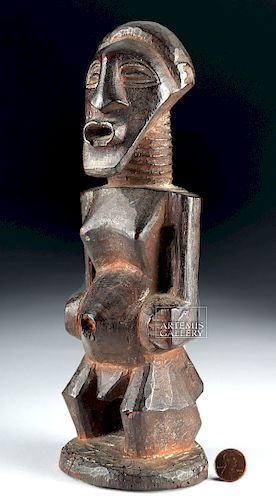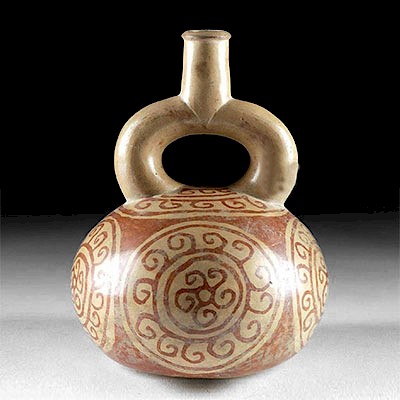Exhibited Early 20th C. Songye Nkisi Kalebwe Figure
Lot 109
About Seller
Artemis Fine Arts
686 S Taylor Ave, Ste 106
Louisville, CO 80027
United States
Selling antiquities, ancient and ethnographic art online since 1993, Artemis Gallery specializes in Classical Antiquities (Egyptian, Greek, Roman, Near Eastern), Asian, Pre-Columbian, African / Tribal / Oceanographic art. Our extensive inventory includes pottery, stone, metal, wood, glass and textil...Read more
Categories
Estimate:
$2,000 - $3,000
Absentee vs Live bid
Two ways to bid:
- Leave a max absentee bid and the platform will bid on your behalf up to your maximum bid during the live auction.
- Bid live during the auction and your bids will be submitted real-time to the auctioneer.
Bid Increments
| Price | Bid Increment |
|---|---|
| $0 | $25 |
| $300 | $50 |
| $1,000 | $100 |
| $2,000 | $250 |
| $5,000 | $500 |
| $10,000 | $1,000 |
| $20,000 | $2,500 |
| $50,000 | $5,000 |
| $100,000 | $10,000 |
| $200,000 | $20,000 |
About Auction
By Artemis Fine Arts
Jan 24, 2019
Set Reminder
2019-01-24 10:00:00
2019-01-24 10:00:00
America/New_York
Bidsquare
Bidsquare : Pre-Columbian / Ethnographic Art
https://www.bidsquare.com/auctions/artemis-gallery/pre-columbian-ethnographic-art-3814
Featuring ancient and ethnographic art from around the world, including Pre-Columbian, Native American, African / Tribal, Ethnographic, Spanish Colonial, Fossils, Fine Art, much more. Artemis Fine Arts info@artemisgallery.com
Featuring ancient and ethnographic art from around the world, including Pre-Columbian, Native American, African / Tribal, Ethnographic, Spanish Colonial, Fossils, Fine Art, much more. Artemis Fine Arts info@artemisgallery.com
- Lot Description
Central Africa, northern Democratic Republic of the Congo, Songye peoples, ca. early 20th century CE. A striking "nkisi" (male) power figure, hand-carved from hard wood. The The Kalebwe-style figure is defined by a distended abdomen with a recessed navel, bar-shaped arms with blocky hands, planar shoulders flanking a wide chest, and a ringed neck, all atop attenuated legs attached to an integral circular base. The oblong head boasts a flared nose, full lips around an open mouth, incised semicircular eyes with delineated pupils, and petite ears beneath a domed head with a vertical carved hole on top. Layers of rich coffee and caramel-hued patina envelop the figure and provide for an elegant presentation. Size: 3.375" W x 10" H (8.6 cm x 25.4 cm).
Songye power figures are created to protect a community and mediate between the living and spiritual realms to cure ailments. Figures that are employed in ceremonial uses have real horns protruding from the center of the head and often also exhibit hammered brass panels which are applied to the face. Power figures are kept in a sanctuary under the care of a guardian when not in use.
The piece exhibits a few characteristics which are unique to Songye artistry. Kalebwe figures, from the northern region of the Democratic Republic of the Congo, tend to have chins with a square profile rather than rounded chins typical of the southern Kibeshi figures. The second feature is the hollowed receptacle at the top of the head which is intended for the insertion of fetish material, known as "bishimba," which symbolically imbues the figure with special powers. According to Jean-Baptist Bacquart, "A 'specialist', called the Nganga, then attached magical objects such as snakeskins, feathers, metal necklaces and bracelets to the figure to enhance the power even more. Occasionally these figures are suspended for apotropaic purposes inside a house by inserting a metal rod under each arm." ("The Tribal Arts of Africa: Surveying Africa's Artistic Geography." Thames & Hudson, New York, 2000, p. 168)
Exhibited at Pace Gallery in New York City in the 1990s
For a similar example with copper and snake-skin adornments, please see: Bacquart, Jean-Baptiste. "The Tribal Arts of Africa: Surveying Africa's Artistic Geography." Thames & Hudson, New York, 2000, p. 168, fig. 2.
A stylistically-similar example with undefined legs hammered for EUR 100,000 ($114,077.10) at Christie's, Paris "Arts d'Afrique, d'Oceanie et d'Amerique" auction (sale 16061, April 10, 2018, lot 83): https://www.christies.com/lotfinder/lot/statue-songye-kalebwe-songye-kalebwe-figure-republique-democratique-6132261-details.aspx?from=searchresults&intObjectID=6132261&sid=c1a65fb0-efed-4de7-a810-dcc7b3fc9f92
Provenance: ex-private old New England, USA collection, acquired in the 1970s; exhibited at Pace Gallery, New York, New York, USA in the 1990s (small white oval sticker beneath base); ex-Peter Pollack collection, acquired in the early 1960s
All items legal to buy/sell under U.S. Statute covering cultural patrimony Code 2600, CHAPTER 14, and are guaranteed to be as described or your money back.
A Certificate of Authenticity will accompany all winning bids.
We ship worldwide and handle all shipping in-house for your convenience.
#140538Minor nicks to head, body, arms, legs, and base, with some softening to finer features, and some insect damage around the base, otherwise intact and excellent. Light earthen deposits and fabulous, varied brown patina throughout. Old inventory labels beneath base.Condition
- Shipping Info
-
All shipping is handled in-house for your convenience. Your invoice from Artemis Gallery will include shipping calculation instructions. If in doubt, please inquire BEFORE bidding for estimated shipping costs for individual items.
-
- Buyer's Premium



 EUR
EUR CAD
CAD AUD
AUD GBP
GBP MXN
MXN HKD
HKD CNY
CNY MYR
MYR SEK
SEK SGD
SGD CHF
CHF THB
THB
















